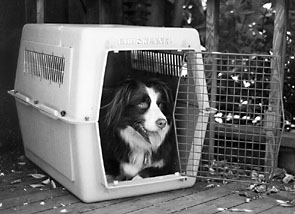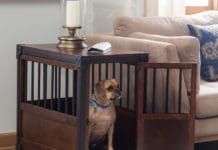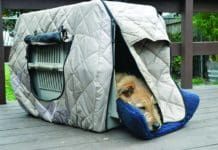[Updated October 3, 2017]
Crates are perhaps second only to choke collars as the most misused training equipment forced upon dogs. However, unlike choke collars, there is a terrific training principle behind the use of crates.
A crate, or, in other words, short-term close confinement, can be used to help dogs teach themselves two very important skills. The first is eliminating only when and where it is appropriate. The second skill is keeping out of trouble – behaving appropriately in the house. Without these two skills, a dog doesn’t have much of a chance in this world.

But before I tell you how to help your dog learn these skills, let me say what crates should not be used for.
What Dog Crates are NOT For
They are not for punishing your dog for doing something wrong; if used in this way, the dog will quickly learn to avoid ever going in the crate, or how to be as obnoxious as possible in order to get let out.
They are not for “warehousing” a number of dogs, so you don’t have too many underfoot. I have to say that breeders abuse the use of crates more than all other dog owners. You often see breeders who don’t actually want to live with the dogs they breed and raise; they use crates to contain their “merchandise,” keep it out of the way until it’s ready to sell. This is in itself objectionable, even more so when they force this prison concept of the crate upon the people who buy their dogs and puppies. I can’t tell you how many people I’ve spoken to who faithfully lock their perfectly well-behaved dogs in crates for hours every day because the breeder they bought the dog from told them they had to.
Puppies are Babies
Crates are also not for keeping puppies out of trouble all day. Puppies are just like babies; they need to be watched every minute, and few puppy owners seem to understand this. People make arrangements for their new babies to be supervised when they are at work or school or going to the movies and so on; they have to learn to do the same with puppies.
Recently, I was talking about this to a dog trainer friend from Manhattan. She was discussing this with a number of students in a dog training class, and several people were having trouble accepting it. Finally, frustrated, she told them, “Look, I’m sorry, I must end the class now, because my two-year-old daughter is at home on her own and I’ve been away for several hours, so I should get back and see how she is.” Everyone went, “WHAT?” And she said, “See? Actually, I don’t have a child, but you accept that you can’t leave one kind of baby alone; why is it any less dangerous or cruel to abandon another one?”
When the puppy gets older, say, six to 12 months old, you can begin leaving it for longer periods of time. However, you can’t just go out the door and hope for the best. You have to teach your puppy how to cope with short-term close confinement, and later, with long-term confinement.
Simply stated, crates are not for long-term close confinement of puppies or adult dogs. They are too small; any animal suffers when it is forced to stay that closely confined for more than a few hours.
Long-Term Dog Confinement
Until your new dog is house-trained, you can’t give it the run of the house all day while you are at work – it would get into trouble – but you can’t put it in the crate, either.
In my opinion, you can view each mistake a dog makes while you’re gone all day as 20 mistakes, because one puddle, or one little chew, sets the precedent for many other mistakes. And when the dog’s bladder and teeth get bigger, and bigger mistakes are made, the dog will be put outside, where it will then learn to dig and bark, and then the neighbors will complain, and then it goes into the garage as a temporary stop, before it goes to the humane society to play the Lotto of life, where only one out of eight dogs win.
So, instead, when you’re away from home, you use long-term confinement to keep him or her out of trouble. The most suitable place for teaching long-term confinement would be a bathroom, one with all the toilet paper, towels, shower curtains, and carpets removed. You’d leave only a few things in there: the dog’s bed (which could be a cozy blanket placed in a crate with the door open), an adequate supply of water, some safe hollow chew toys which are stuffed with food treats, and the dog’s toilet. For the latter, I suggest something like two short rolls of turf on a sheet of plastic. The benefit of this, rather than those commercial puppy pads, is the dog will train itself to urinate on turf or dirt.
If your new dog is extremely anxious, and it takes desperate measures to escape, such as tearing the bathroom door apart, you can’t use this method. You will need to consult a professional for advice on dealing with about extreme separation anxiety.
The long-term confinement method is a temporary measure, only meant to keep your new dog out of trouble until you have the time to potty- and house-train it.
Crates for “Potty Training”
All right. Back to what crates are for! The first proper use of a crate, as I said, is for teaching a puppy or dog to eliminate only when and where it is appropriate.
You can teach this to an adult dog within three days. This is something we did with the San Francisco SPCA in the mid-1980s, when I started the animal behavior program there. We taught the volunteers how to take home dogs that weren’t house-trained and house-train them using the umbilical cord method, where the dog is tied to your waist, so you can watch it every second. Then, every hour on the hour you take it outside, to the place where you want it to eliminate. When they do, you give them three liver treats, take them back inside, and let them off the leash for a little while. If they do not eliminate, they do not get a treat, and they go back inside still on the leash. By four days of this, there were no longer any mistakes; the dog thoroughly wants to use its dog toilet.
Puppies may or may not take a little longer to potty-train. Your consistency will make all the difference.
When at home, confine the puppy all the time that you can not watch it 110 percent. Few dogs or puppies will soil their bedrooms unless they are really desperate; don’t keep the puppy (or a dog, for that matter) in there long enough to get desperate.
Every hour on the hour, release the puppy, saying, “Let’s go potty!” and run with it to its doggie toilet. (Running is helpful because you don’t want an accident to happen on the way to the toilet, and because running “jiggles” its bladder and bowels.) Most puppies will urinate within two minutes. If it does, give it three liver treats, and go back in the house. By doing this, you actually give the puppy the desire to wait until you come home and take it outside to eliminate, because that’s the only time it can cash in its urine and feces for liver treats.
Once it has eliminated, then you can take it back into the house and turn it loose, where your empty puppy can spend some time exploring the house under supervision. Then you’ve only got to watch that it doesn’t chew the wrong things! After an hour or so, put it back into the crate, and start the process over again.
However, if it doesn’t eliminate, it goes back in the crate for another hour, and you start over again.
House-Training Your Dog
“Potty-training” is what most people are worried about, of course, but what I call “house-training” is just as important, and, fortunately, it’s a nice side-effect of crate-training. In just a matter of days, the dog will learn that every time he is confined, he gets to chew on toys, and soon, he’ll become addicted to chewing toys. That means he won’t destroy the rest of your house, and it mean he won’t become a recreational barker. He’ll still alert when the doorbell rings, but recreational chewers almost never become one of those annoying chronic barkers.
The dog will also self-train itself to settle down and to enjoy time spent when at home alone. After a week or two of this procedure, the adult dog can safely enjoy the full run of his home for the rest of his life. Again, I do not advise that puppies are left alone – for any length of time – until they are at least 12 amonths old.
Crate-Training Mistakes
The most common mistake I see people making with their crates is using it as a prison, or shoving the dog into the crate when he’s been “bad.” That’s the very best way to teach him to avoid going into the crate at any time.
Instead, a dog should regard the crate as his play room, his doggie den. Confining a dog or puppy to a crate should be on par with confining your child to a room with a TV and VCR, a Sega, and a ton of toys. This is a simple thing to teach puppies. When a puppy is tired and hungry, you put him in the crate along with his dinner and some toys, and you leave him there. He’ll eat his dinner and fall asleep.
If someone has taught an adult dog to have apprehensions about the crate, though, it will probably take at least a few days to overcome them. The process here will be a little different; he’ll need additional time to get over his anxiety that he will be locked and trapped in the crate. While you are trying to convince him of this, don’t lock and trap him in the crate!
Dog Training Theory
The point of “training” is to make the dog want to do what you want it to do. If your dog doesn’t want to be in the crate – if he has only unpleasant associations with it – use your head. How can you make a dog want to be in the crate? Food is one way.
First, I would always feed this dog in his crate, and make the most of his daily ration by feeding it to him in numerous courses – as many as a dozen, even. I’d put a little food in the crate, let him go in and eat it, and then let him out right after he’s finished. I’d also make the final course of the day a big one, mixing his kibble with some juicy canned food. Put the bowl in the crate and then shut the door, with the dog on the outside, and let the dog think about this for a while. After a minute, he’ll be saying, “Hey! Open the crate door! Let me in!” This is what training is all about. When your dog is pleading to get in its crate, let it in!
Here’s another tactic. Throw a bit of kibble in the crate. Let him go in and get it; he’ll come right out again. Do this three or four times. Then, throw a bit of kibble in, and when he goes in to get it, shut the door and immediately feed him another couple of bits of kibble through the bars. Then, let him out, and ignore him for three minutes. Then, put a bit of kibble in the crate, shut the door, feed him five bits of kibble through the bars, and then let him out and ignore him for five minutes.
The next time, put a bunch of kibble in a Kong toy, along with some freeze-dried liver and a bit of honey in the Kong, so it is difficult to get the food out, and put the Kong in the crate. Let the dog in and shut the door. Before he’s finished trying to get all the food out, after about 10 minutes, open the door, let him out, take the Kong away, and ignore him for five minutes.
What is the dog learning? “When I’m in the crate, my owner talks to me all the time, she sits next to me and reads me a book, and keeps feeding me. And there are toys in the crate. There are no toys anywhere else – that crate is OK!”
If a dog is expressing dissatisfaction with its lot, you haven’t really done your job as a trainer to teach him to want to do what you want him to do.
Every dog develops favorite places to lie down. If you’ve crate-trained your dog properly, that favorite place will be in the crate with the door open. If the dog goes there of his own accord, it’s a good sign that you have done a good job as a trainer.
Dr. Dunbar is the founder of the Association of Pet Dog Trainers, the creator of the K9 Games, and is best known for his SIRIUS Puppy Training program.






This is the BEST crate training I’ve ever heard/read. The essence of training a new family member is kindness and love. Why else would you get a dog? This is what males Dr. Dunbar the finest trainer anywhere.